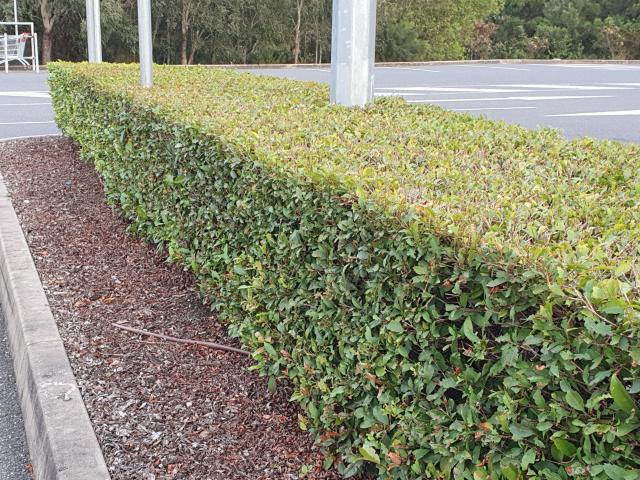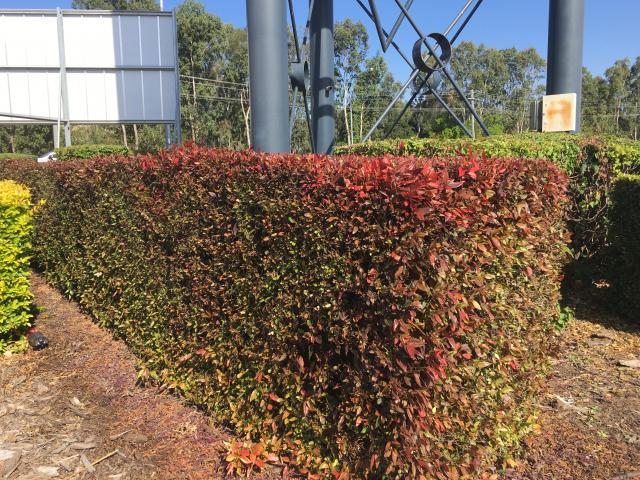Many gardeners may believe the Hedges are only a new fad but Hedges through the ages have consisted of many things to many people.
It can be a simple demarcation to design from luxuriance to privacy.
Used wisely in a garden layout, a hedge is a wonderful thing with colour, contrast and even a device to create anticipation.
Nothing is more suggestive of space and perspective than a hedge.
In the small town of Rolleston there is an old Clerodendrum heterophyllum hedge that does this as well as provides a green feature in the town’s main street.
This variety of Clerodendrum would be one of original hedging shrubs used in this region.
Clerodendrum heterophyllum is a densely branched shrub with either gold or dark green foliage.
One of the most important areas in which to give your hedges a good start is preparing the soil properly.
As plants in a hedge are planted very close together, they compete for food and water, so it is essential that the soil is open, with a high amount of vegetable matter like compost, cow manure or even peat moss.
Close spacing of the plants is necessary to form a dense mass of foliage and stems.
Too great a distance between the hedging plants means they may take much longer to grow together.
A good scale I have found for working plant spacing’s is to find out the established plants width and make planting distance one-quarter or one-fifth of this distance apart.
If the plants are too far apart, they may take much longer to grow together.
Mulching of the hedge is another important aspect, using anything from cheap straw mulch to the neat and attractive, but highly-priced, pine bark fines.
This will slow the evaporation rate, preventing the plants from wilting and then developing small, distorted leaves.
Within the first twelve months of establishing your hedge, you should commence clipping, with the general aim of making a short, bushy hedge first, then allowing the height and width to increase as desired.
Some people may think this is a lengthier method, but a dense, well-leafed shrub will justify the extra time involved.
The most popular plants used for screening are those which are fast growing and relatively inexpensive.
The following are some of the hardiest Hedging plants without thorns available for a living fence or screen.
Acalypha wilkesiana and hybrid varieties like Firestorm, Inferno, Spitfire are probably one of the hardiest of all available hedging plants, with varying sizes and shapes.
Some Acalypha varieties have been grown in Central Queensland for almost a hundred years.
For best results, they require warmth, high humidity and plenty of liquid fertiliser.
Brunfelsia latifolia is a hardy and popular highly scented old-fashioned shrub is also known as Franciscea or Yesterday Today and Tomorrow.
It will grow up to two metre by two metre but can be kept lower.
Brunfelsia latifolia looks striking in spring when covered with flowers from purple flowers fading through mauve to white and the lush green foliage looks great at any other time of the year.
The uses for Brunfelsias in the garden include being a perfumed feature shrubs to colourful hedging plants.
They can even be used as large potted plants, in fact the more root bound the plant becomes the better the flowering.
Ficus Green Island is a compact low growing shrub with dense round glossy foliage.
It is idea as a ground coverage plant or a low hedging plant in exposed positions.
Ficus Green Island is wind tolerant, drought tolerant, salt-tolerant as well as provides a low maintenance feature.
Regular pruning and shaping will produce the best presented hedge.
Syzygium paniculatum hybrids or Lilly-pilly would privide some of the best hedging plants available to local gardeners.
There are dozens of hybrids on the market but some of the best hedging varieties are Syzygium Aussie Boomer, Aussie Copper, Bush Christmas, Copperhedge, Elegance, Hinterland Gold and Select.
The parent of these hybrids, Syzygium paniculatum, is found growing naturally in the mountains around Rockhampton.
It has glossy green leaves, coloured new growth, and creamy white flowers, by rose-purple berries.
They say that good fences make good neighbours.
Choosing a living fence can be as effective, less expensive and most of all can be an enjoyable and attractive part of the garden.











